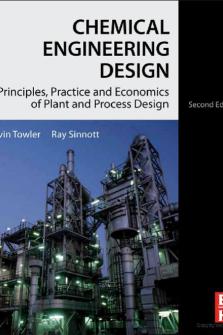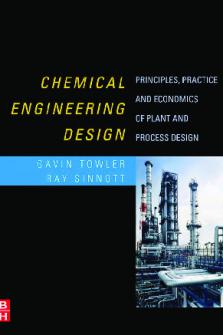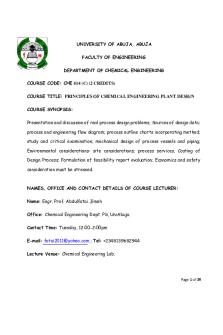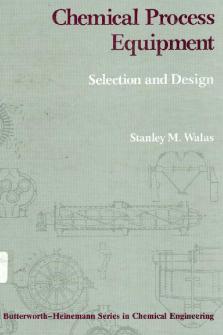Chemical Engineering Design Principles, Practice and Economics of Plant and Process Design - Copy.pdf PDF

| Title | Chemical Engineering Design Principles, Practice and Economics of Plant and Process Design - Copy.pdf |
|---|---|
| Author | Sitha Nurfitriani |
| Pages | 1,266 |
| File Size | 23.3 MB |
| File Type | |
| Total Downloads | 404 |
| Total Views | 916 |
Summary
CHEMICAL ENGINEERING DESIGN This page intentionally left blank CHEMICAL ENGINEERING DESIGN Principles, Practice and Economics of Plant and Process Design GAVIN TOWLER RAY SINNOTT AMSTERDAM • BOSTON • HEIDELBERG • LONDON NEW YORK • OXFORD • PARIS • SAN DIEGO SAN FRANCISCO • SINGAPORE • SYDNEY • TOKY...
Description
CHEMICAL ENGINEERING DESIGN
This page intentionally left blank
CHEMICAL ENGINEERING DESIGN Principles, Practice and Economics of Plant and Process Design GAVIN TOWLER RAY SINNOTT
AMSTERDAM • BOSTON • HEIDELBERG • LONDON NEW YORK • OXFORD • PARIS • SAN DIEGO SAN FRANCISCO • SINGAPORE • SYDNEY • TOKYO Butterworth-Heinemann is an imprint of Elsevier
Butterworth-Heinemann is an imprint of Elsevier 30 Corporate Drive, Suite 400, Burlington, MA 01803, USA 525 B Street, Suite 1900, San Diego, California 92101-4495, USA 84 Theobald’s Road, London WCIX 8RR, UK This book is printed on acid-free paper. Copyright © 2008, Elsevier Inc. All rights reserved. No part of this publication may be reproduced or transmitted in any form or by any means, electronic or mechanical, including photocopy, recording, or any information storage and retrieval system, without permission in writing from the publisher. Permissions may be sought directly from Elsevier’s Science & Technology Rights Department in Oxford, UK: phone: (+44) 1865 843830, fax: (+44) 1865 853333, E-mail: [email protected]. You may also complete your request on-line via the Elsevier homepage (http://elsevier.com), by selecting ‘‘Support & Contact’’ then ‘‘Copyright and Permission’’ and then ‘‘Obtaining Permissions.’’ No responsibility is assumed by the publisher or the authors for any injury and/or damage to persons or property as a matter of products liability, negligence or otherwise, of from any use or operation of any methods, products, instructions, data or ideas contained in the material herein. Library of Congress Cataloging-in-Publication Data Application Submitted British Library Cataloguing-in-Publication Data A catalogue record for this book is available from the British Library. ISBN 13: 978-0-7506-8423-1 For information on all Butterworth-Heinemann publications visit our Web site at www.books.elsevier.com Printed in the United States of America 07 08 09 10 9 8 7 6 5 4 3 2 1 Cover Design: Joe Tenerelli
Gavin Towler is the Senior Manager of Process Design, Modeling and Equipment at UOP LLC. He manages the areas of process design and optimization, equipment design, and physical and kinetic modeling for UOP Research and Development. As adjunct professor at Northwestern University, he teaches the chemical engineering senior design classes. He is a Chartered Engineer and Fellow of the Institute of Chemical Engineers. Ray Sinnott began his career in design and development with several major companies, including DuPont and John Brown. He later joined the Chemical Engineering Department at the University of Wales, Swansea, UK, publishing the first edition of Chemical Engineering Design in 1983. He is a Chartered Engineer, Eur. Ing. and Fellow of the Institute of Chemical Engineers.
This page intentionally left blank
CONTENTS
PREFACE xv HOW TO USE THIS BOOK ACKNOWLEDGMENTS
1
INTRODUCTION TO DESIGN 1.1. 1.2. 1.3. 1.4. 1.5. 1.6. 1.7. 1.8. 1.9. 1.10. 1.11. 1.12.
2
xvii
xix
1
Introduction 2 Nature of Design 2 The Anatomy of a Chemical Manufacturing Process 8 The Organization of a Chemical Engineering Project 11 Project Documentation 13 Codes and Standards 16 Design Factors (Design Margins) 17 Systems of Units 18 Optimization 19 References 44 Nomenclature 44 Problems 45
FUNDAMENTALS OF MATERIAL BALANCES 2.1. 2.2. 2.3. 2.4. 2.5. 2.6. 2.7. 2.8. 2.9. 2.10.
49
Introduction 50 The Equivalence of Mass and Energy 50 Conservation of Mass 51 Units Used to Express Compositions 51 Stoichiometry 52 Choice of System Boundary 53 Choice of Basis for Calculations 56 Number of Independent Components 57 Constraints on Flows and Compositions 58 General Algebraic Method 59 vii
viii
CONTENTS
2.11. 2.12. 2.13. 2.14. 2.15. 2.16. 2.17. 2.18. 2.19. 2.20. 2.21.
3
74
FUNDAMENTALS OF ENERGY BALANCES AND ENERGY UTILIZATION 81 3.1. 3.2. 3.3. 3.4. 3.5. 3.6. 3.7. 3.8. 3.9. 3.10. 3.11. 3.12. 3.13. 3.14. 3.15. 3.16. 3.17. 3.18. 3.19. 3.20.
4
Tie Components 60 Excess Reagent 62 Conversion, Selectivity, and Yield 63 Recycle Processes 68 Purge 70 Bypass 71 Unsteady-State Calculations 72 General Procedure for Material-Balance Problems References 75 Nomenclature 75 Problems 76
Introduction 82 Conservation of Energy 82 Forms of Energy (Per Unit Mass of Material) 83 The Energy Balance 84 Calculation of Specific Enthalpy 89 Mean Heat Capacities 90 The Effect of Pressure on Heat Capacity 92 Enthalpy of Mixtures 94 Enthalpy-Concentration Diagrams 95 Heats of Reaction 98 Standard Heats of Formation 101 Heats of Combustion 102 Compression and Expansion of Gases 104 Energy Balance Calculations 112 Unsteady State Energy Balances 113 Energy Recovery 114 Heat Exchanger Networks 124 References 145 Nomenclature 146 Problems 150
FLOWSHEETING 153 4.1. 4.2. 4.3. 4.4.
Introduction 154 Flowsheet Presentation 155 Process Simulation Programs 162 Specification of Components and Physical Property Models
165
ix
CONTENTS
4.5. 4.6. 4.7. 4.8. 4.9. 4.10. 4.11. 4.12.
5
PIPING AND INSTRUMENTATION 5.1. 5.2. 5.3. 5.4. 5.5. 5.6. 5.7. 5.8. 5.9. 5.10. 5.11. 5.12. 5.13.
6
Simulation of Unit Operations 169 User Models 204 Flowsheets with Recycle 207 Flowsheet Optimization 219 Dynamic Simulation 224 References 224 Nomenclature 225 Problems 226
235
Introduction 236 The P and I Diagram 236 Valve Selection 241 Pumps and Compressors 243 Mechanical Design of Piping Systems 262 Pipe Size Selection 265 Control and Instrumentation 275 Typical Control Systems 277 Alarms, Safety Trips, and Interlocks 285 Computers in Process Control 287 References 289 Nomenclature 291 Problems 293
COSTING AND PROJECT EVALUATION 6.1. 6.2. 6.3. 6.4. 6.5. 6.6. 6.7. 6.8. 6.9. 6.10. 6.11. 6.12.
Introduction 298 Costs, Revenues, and Profits 298 Estimating Capital Costs 306 Estimating Production Costs and Revenues Taxes and Depreciation 352 Project Financing 358 Economic Evaluation of Projects 363 Sensitivity Analysis 380 Project Portfolio Selection 384 References 388 Nomenclature 390 Problems 392
297
334
x
CONTENTS
7
MATERIALS OF CONSTRUCTION 7.1. 7.2. 7.3. 7.4. 7.5. 7.6. 7.7. 7.8. 7.9. 7.10. 7.11. 7.12. 7.13. 7.14. 7.15. 7.16.
8
397
Introduction 398 Material Properties 398 Mechanical Properties 399 Corrosion Resistance 402 Selection for Corrosion Resistance 407 Material Costs 408 Contamination 409 Commonly Used Materials of Construction 410 Plastics as Materials of Construction for Chemical Plants Ceramic Materials (Silicate Materials) 419 Carbon 421 Protective Coatings 421 Design for Corrosion Resistance 421 References 422 Nomenclature 424 Problems 424
DESIGN INFORMATION AND DATA 8.1. 8.2. 8.3. 8.4. 8.5. 8.6. 8.7. 8.8. 8.9. 8.10. 8.11. 8.12. 8.13. 8.14. 8.15. 8.16. 8.17. 8.18. 8.19.
427
Introduction 428 Sources of Information on Manufacturing Processes 428 General Sources of Physical Properties 430 Accuracy Required of Engineering Data 432 Prediction of Physical Properties 433 Density 434 Viscosity 436 Thermal Conductivity 440 Specific Heat Capacity 442 Enthalpy of Vaporization (Latent Heat) 449 Vapor Pressure 451 Diffusion Coefficients (Diffusivities) 452 Surface Tension 455 Critical Constants 457 Enthalpy of Reaction and Enthalpy of Formation 460 Phase Equilibrium Data 460 References 472 Nomenclature 477 Problems 479
417
xi
CONTENTS
9
SAFETY AND LOSS PREVENTION 481 9.1. 9.2. 9.3. 9.4. 9.5. 9.6. 9.7. 9.8. 9.9. 9.10. 9.11. 9.12.
10
502
EQUIPMENT SELECTION, SPECIFICATION, AND DESIGN 10.1. 10.2. 10.3. 10.4. 10.5. 10.6. 10.7. 10.8. 10.9. 10.10. 10.11. 10.12. 10.13. 10.14. 10.15. 10.16.
11
Introduction 482 Materials Hazards 486 Process Hazards 493 Analysis of Product and Process Safety Failure-Mode Effect Analysis 503 Safety Indices 506 Hazard and Operability Studies 517 Quantitative Hazard Analysis 526 Safety Checklists 531 References 534 Nomenclature 538 Problems 538
Introduction 542 Separation Processes 543 Solid-Solid Separations 543 Liquid-Solid (Solid-Liquid) Separators 550 Separation of Dissolved Solids 577 Liquid-Liquid Separation 582 Separation of Dissolved Liquids 590 Gas-Solid Separations (Gas Cleaning) 591 Gas-Liquid Separators 603 Crushing and Grinding (Comminution) Equipment Mixing Equipment 609 Transport and Storage of Materials 620 Reactors 626 References 630 Nomenclature 635 Problems 637
609
SEPARATION COLUMNS (DISTILLATION, ABSORPTION, AND EXTRACTION) 641 11.1. 11.2. 11.3. 11.4. 11.5. 11.6.
Introduction 642 Continuous Distillation: Process Description 642 Continuous Distillation: Basic Principles 645 Design Variables in Distillation 650 Design Methods for Binary Systems 652 Multicomponent Distillation: General Considerations
665
541
xii
CONTENTS
11.7. 11.8. 11.9. 11.10. 11.11. 11.12. 11.13. 11.14. 11.15. 11.16. 11.17. 11.18. 11.19.
12
HEAT TRANSFER EQUIPMENT 12.1. 12.2. 12.3. 12.4. 12.5. 12.6. 12.7. 12.8. 12.9. 12.10. 12.11. 12.12. 12.13. 12.14. 12.15. 12.16. 12.17. 12.18. 12.19. 12.20. 12.21.
13
Multicomponent Distillation: Shortcut Methods for Stage and Reflux Requirements 667 Multicomponent Systems: Rigorous Solution Procedures (Computer Methods) 693 Other Distillation Systems 697 Plate Efficiency 698 Approximate Column Sizing 708 Plate Contactors 709 Plate Hydraulic Design 716 Packed Columns 741 Column Auxiliaries 771 Solvent Extraction (Liquid-Liquid Extraction) 772 References 779 Nomenclature 784 Problems 789
793
Introduction 794 Basic Design Procedure and Theory 795 Overall Heat Transfer Coefficient 796 Fouling Factors (Dirt Factors) 798 Shell and Tube Exchangers: Construction Details 801 Mean Temperature Difference (Temperature Driving Force) 815 Shell and Tube Exchangers: General Design Considerations 820 Tube-Side Heat Transfer Coefficient and Pressure Drop (Single Phase) Shell-Side Heat Transfer and Pressure Drop (Single Phase) 829 Condensers 870 Reboilers and Vaporizers 890 Plate Heat Exchangers 918 Direct-Contact Heat Exchangers 929 Finned Tubes 930 Double-Pipe Heat Exchangers 931 Air-Cooled Exchangers 932 Fired Heaters (Furnaces and Boilers) 932 Heat Transfer to Vessels 938 References 945 Nomenclature 951 Problems 957
MECHANICAL DESIGN OF PROCESS EQUIPMENT 13.1. Introduction 962 13.2. Pressure Vessel Codes and Standards
963
961
823
xiii
CONTENTS
13.3. 13.4. 13.5. 13.6. 13.7. 13.8. 13.9. 13.10. 13.11. 13.12. 13.13. 13.14. 13.15. 13.16. 13.17. 13.18. 13.19. 13.18.
14
Fundamental Principles and Equations 966 General Design Considerations: Pressure Vessels 980 The Design of Thin-Walled Vessels Under Internal Pressure Compensation for Openings and Branches 993 Design of Vessels Subject to External Pressure 995 Design of Vessels Subject to Combined Loading 999 Vessel Supports 1013 Bolted Flanged Joints 1020 Heat Exchanger Tube Plates 1028 Welded-Joint Design 1031 Fatigue Assessment of Vessels 1033 Pressure Tests 1034 High-Pressure Vessels 1035 Liquid Storage Tanks 1038 Pressure-Relief Devices 1038 References 1053 Nomenclature 1056 Problems 1060
GENERAL SITE CONSIDERATIONS 14.1. 14.2. 14.3. 14.4. 14.5. 14.6. 14.7.
1065
Introduction 1066 Plant Location and Site Selection 1066 Site Layout 1068 Plant Layout 1069 Utilities 1074 Environmental Considerations 1076 References 1086
APPENDIX A B C D E F G H I
986
1089
Graphical Symbols for Piping Systems and Plant 1089 Corrosion Chart 1099 Physical Property Data Bank 1119 Conversion Factors for Some Common SI Units 1141 Design Projects I 1145 Design Projects II 1165 Equipment Specification (Data) Sheets 1193 Typical Shell and Tube Heat Exchanger Tube-Sheet Layouts Material Safety Data Sheet 1213
1207
This page intentionally left blank
Preface
This book was first published as Volume 6 of the Chemical Engineering series edited by Coulson and Richardson. It was originally intended to be a standalone design textbook for undergraduate design projects that would supplement the other volumes in the Coulson and Richardson series. Emphasis was placed on the practice of process and equipment design, while the reader was referred to the other volumes in the series and other chemical engineering textbooks for details of the fundamental principles underlying the design methods. In adapting this book for the North American market, we have followed the same philosophy, seeking to create a comprehensive guide to process plant design that could be used as part of the typical chemical engineering curriculum, while providing references to more detailed and specialized texts wherever necessary. The design procedures can be used without the need for reference to the other books, research papers, or websites cited. We recognize that chemical engineers work in a very diverse set of industries, and many of these industries have their own design conventions and specialized equipment. We have attempted to include examples and problems from a broad range of process industries, but where space or our lack of expertise in the subject has limited coverage of a particular topic, references to design methods available in the general literature are provided. In writing this book, we have drawn on our experience of the industrial practice of process design, as well as our experience teaching design at the University of Wales Swansea, University of Manchester, and Northwestern University. Since the book is intended to be used in practice and not just as a textbook, our aim has been to describe the tools and methods that are most widely used in industrial process design. We have deliberately avoided describing idealized conceptual methods developed by researchers that have not yet gained wide currency in industry. The reader can find good descriptions of these methods in the research literature and in more academic textbooks. Standards and codes of practice are an essential part of engineering; therefore, the relevant North American standards are cited. The codes and practices covered by these standards will be applicable to other countries. They will be covered by equivalent national standards in most developed countries, and in some cases the relevant British, European, or International standards have also been cited. Brief
xv
xvi
PREFACE
summaries of important U.S. and Canadian safety and environmental legislation have been given in the relevant chapters. The design engineer should always refer to the original source references of laws, standards, and codes of practice, as they are updated frequently. All of the costs and examples have been put on a U.S. basis, and examples have been provided in both metric and conventional units. Where possible, the terminology used in the U.S. engineering and construction industry has been used. Most industrial process design is carried out using commercial design software. Extensive reference has been made to commercial process and equipment design software throughout the book. Many of the commercial software vendors provide licenses of their software for educational purposes at nominal fees. We strongly recommend that students be introduced to commercial software at as early a stage in their education as possible. The use of academic design and costing software should be discouraged. Academic programs usually lack the quality control and support required by industry, and the student is unlikely to use such software after graduation. All computer-aided design tools must be used with some discretion and engineering judgment on the part of the designer. This judgment mainly comes from experience, but we have tried to provide helpful tips on how to best use computer tools. The art and practice of design cannot be learned from books. The intuition and judgment necessary to apply theory to practice will come only from practical experience. We trust that this book will give its readers a modest start on that road. Ray Sinnott Gavin Towler
How to Use This Book
This book has been written primarily for students in undergraduate courses in chemical engineering and has particular relevance to their senior design projects. It should also be of interest to new graduates working in industry who find they need to broaden their knowledge of unit operations and design. Some of the earlier chapters of the book can also be used in introductory chemical engineering classes and by other disciplines in the chemical and process industries.
As a Senior Design Course Textbook Chapters 1 to 9 and 14 cover the basic material for a course on process design and include an explanation of the design method, including considerations of safety, costing, and materials selection. Chapters 2, 3, and 8 contain a lot of background material that should have been covered in earlier courses and can be quickly skimmed as a reminder. If time is short, Chapters 4, 6, and 9 deserve the most emphasis. Chapters 10 to 13 cover equipment selection and design, including mechanical aspects of equipment design. These important subjects are often neglected in the chemical engineering curriculum. The equipment chapters can be used as the basis for a second course in design or as supplementary material in a process design class.
As an Introductory Chemical Engineering Textbook The material in Chapters 1, 2, 3, and 6 does not require any prior knowledge of chemical engineering and can be used as an introductory course in chemical engineering. Much of the material in Chapters 7, 9, 10, and 14 could also be used in an introductory class. There is much to be said for introducing design at an early point in the chemical engineering curriculum, as it helps the students have a better appreciation of the purpose of their other required classes, and sets the context for the rest of the syllabus. Students starting chemical engineering typically find the practical applications of the subject far more fascinating than the dry mathematics they are usually fed. An appreciation of economics, optimization, and equipment design can dramatically improve a student’s performance in other chemical engineering classes. xvii
xviii
HOW TO USE THIS BOOK
If the book is used in an introductory class, then it can be referred to throughout the curriculum as a guide to design methods.
Supplementary Material Many of the calculations described in the book can be performed using spreadsheets. Templates of spreadsheet calculations and equipment specification sheets are available in Microsoft Excel format online and can be downloaded by all readers of this book from http://books.elsevier.com/companions.
Resources for Instructors Supplementary material is available for registered instructors who adopt Chemical Enginering Design as a course text. Please visit http://textbooks.elsevier.com for information and to register for access to the following resources. Lecture Slides
Microsoft PowerPoint presentations to support most of the chapters are available free of charge to instructors who adopt this book. To preview PDF samples of the slides please register with the site above. A complete set of slides on CD, in customizable PowerPoint format, will be sent to qualifying adopters on request. Image Bank
A downloadable image bank of artwork from the book to use in lecture presentations is available. Instructor’s Manua...
Similar Free PDFs

Chemical Process Design and Simulation
- 418 Pages

chemical engineering design project
- 383 Pages

CH3-Product and Process Design
- 29 Pages
Popular Institutions
- Tinajero National High School - Annex
- Politeknik Caltex Riau
- Yokohama City University
- SGT University
- University of Al-Qadisiyah
- Divine Word College of Vigan
- Techniek College Rotterdam
- Universidade de Santiago
- Universiti Teknologi MARA Cawangan Johor Kampus Pasir Gudang
- Poltekkes Kemenkes Yogyakarta
- Baguio City National High School
- Colegio san marcos
- preparatoria uno
- Centro de Bachillerato Tecnológico Industrial y de Servicios No. 107
- Dalian Maritime University
- Quang Trung Secondary School
- Colegio Tecnológico en Informática
- Corporación Regional de Educación Superior
- Grupo CEDVA
- Dar Al Uloom University
- Centro de Estudios Preuniversitarios de la Universidad Nacional de Ingeniería
- 上智大学
- Aakash International School, Nuna Majara
- San Felipe Neri Catholic School
- Kang Chiao International School - New Taipei City
- Misamis Occidental National High School
- Institución Educativa Escuela Normal Juan Ladrilleros
- Kolehiyo ng Pantukan
- Batanes State College
- Instituto Continental
- Sekolah Menengah Kejuruan Kesehatan Kaltara (Tarakan)
- Colegio de La Inmaculada Concepcion - Cebu








![[13]-transformer design and principles](https://pdfedu.com/img/crop/172x258/eq53k3g813zr.jpg)



